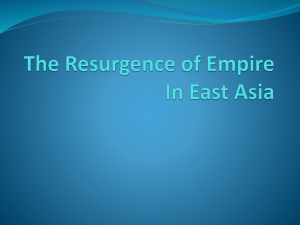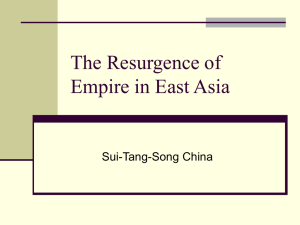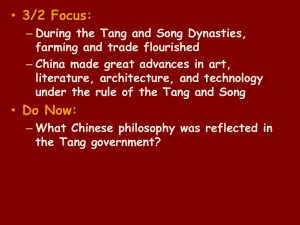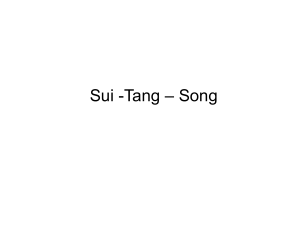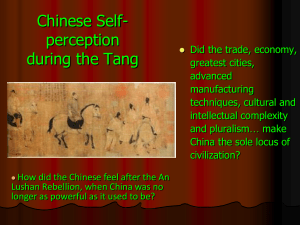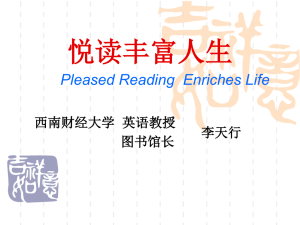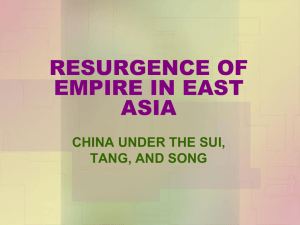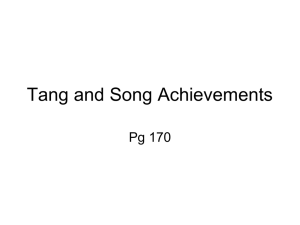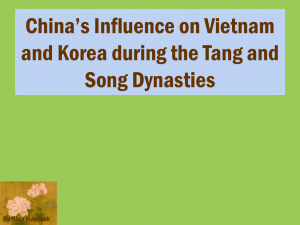Tang and Song Dynasties
advertisement
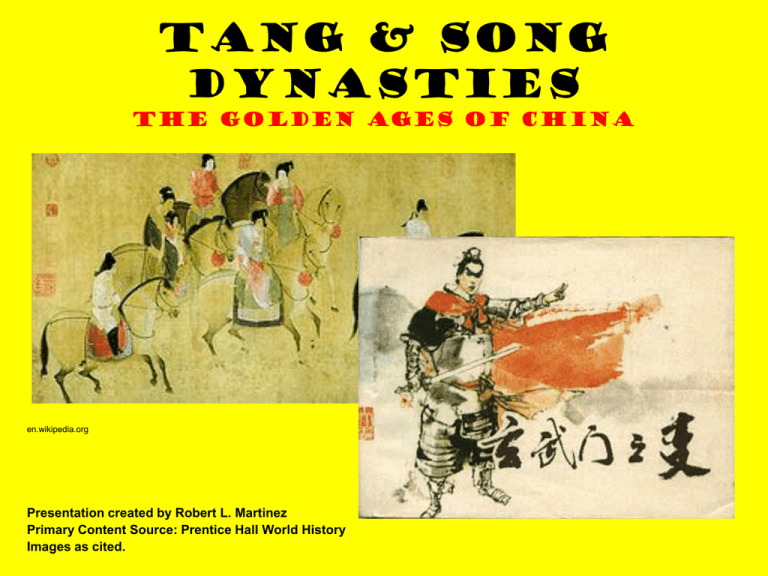
Tang & Song Dynasties The Golden Ages of China en.wikipedia.org Presentation created by Robert L. Martinez Primary Content Source: Prentice Hall World History Images as cited. After the Han Dynasty collapsed in 220, China remained divided for nearly 400 years. Yet China escaped the decay that disrupted Western Europe after the fall of Rome. wacksclass.blogspot.com Farm production expanded and technology slowly improved. Buddhism spread while learning and the arts continued. artsconnected.org Even Chinese cites survived. Although invaders stormed northern China, they others adopted Chinese civilization rather than demolishing it. people.cohums.ohio-state.edu Meanwhile, various dynasties rose and fell in the south. But China would not be restored to its earlier glory until the emergence of the Tang Dynasty in 618. nationsonline.org The 1st Tang emperor, Li Yuan, was a general under the Sui dynasty. When the Sui began to crumble, his ambitious 16 year-old son Li Shimin, urged him to lead a revolt. Father and son crushed all rivals and established the Tang dynasty. history.cultural-china.com Eight years later, Li Shimin compelled his aging father to step down and mounted the throne himself, taking the name Tang Taizong. pureinsight.org Brilliant general, government reformer, historian, and master of the calligraphy brush, Tang Taizong would become China’s most admired emperor. history.cultural-china.com Tang armies forced the neighboring lands of Vietnam, Tibet, and Korea to become tributary states. While these states remained independent, their rulers had to acknowledge Chinese supremacy and send regular tribute to the Tang emperor. history.cultural-china.com Tang rulers, such as Empress Wu Zhao, helped restore the Han system of uniform government throughout China. They rebuilt the bureaucracy and enlarged the civil service system to recruit talented officials trained in Confucian philosophy. history-of-china.com Tang emperors instituted a system of land reform. They broke up large agricultural holdings and redistributed the land to peasants. This policy strengthened the central government by weakening the power of large landowners. sirlaugh.wordpress.com These policies increased government revenues, since the peasants who farmed their own land would be able to pay taxes. china-lover.livejournal.com Under the Tang, a system of canals encouraged internal trade and transportation. The Grand Canal linked the Huang He to the Yangzi River. As a result, food grown in the south could be shipped to the capital in the north. china-mike.com At the time, the Grand Canal was the largest waterway ever dug by human labor. history.cultural-china.com Like earlier dynasties, the Tang eventually weakened. Corruption, high taxes, drought, famine, and rebellions all contributed to the downward swing of the dynastic cycle. In 907, a rebel general overthrew the last Tang emperor. history.cultural-china.com In 963, a scholarly general reunited much of China and founded the Song dynasty. The Song ruled 319 years, slightly longer than the Tang, however, the Song controlled less territory than the Tang. commons.wikimedia.org In addition, the Song faced the constant threat of invaders in the north. In the early 1100s, the battered Song retreated south of the Huang He. There, the Southern Song continued to rule for another 150 years. kaleidoscope.cultural-china.com Chinese wealth and culture dominated East Asia even when its armies did not. Under the Song, the Chinese economy expanded. chinahighlights.com The center of farming shifted from the wheat fields to the rice paddies of the Yangzi in the south. New strains of rice and improved irrigation methods helped peasants produce two rice crops a year. shutterstock.com The rise in productivity created surpluses, allowing more people to pursue commerce, learning, or the arts. bo-ryehnchinesework.blogspot.com Under both the Tang and Song, foreign trade flourished. Merchants arrived from India, Persia, and Arabia. Chinese merchants carried goods to Southeast Asia in exchange for spices. Song porcelain has been found as far away as East Africa. ancienthistory.about.com To improve trade, the government issued paper money. China’s cities, which had been mainly centers of government, now prospered as centers of trade. numismondo.com Under the Tang and Song, China was a well-ordered society. At is head was the emperor, whose court was filled with aristocratic families. suzan-abrams.blogspot.com The court supervised a huge bureaucracy from which officials fanned out to every part of China. Aside from the court, China’s two main social classes were the gentry and the peasantry. ichina.org.uk Most scholar-officials at court came from the gentry, or wealthy-landowning class. They alone could afford to spend years studying the Confucian classics in order to pass the grueling civil service exam. factsanddetails.com Most Chinese were peasants who worked the land, living on what they produced. Drought and famine were a constant threat, but new tools and crops did improve the lives of many peasants. 7j2012.blogspot.com Some merchants acquired vast wealth. Still, according to Confucian tradition, merchants had an even lower social status than peasants because their riches came from the labor of others. smashalloldthings.blogspot.com Along with poetry, painting and calligraphy were essential skills for the scholarly-gentry. In both of these crafts, artists sought balance and harmony through the mastery of simple strokes and lines. newworldencyclopedia.org The Song period saw the triumph of Chinese landscape painting. Steeped in the Daoist tradition, painters sought to capture the spiritual essence of the natural world. Misty mountains and delicate bamboo forests dominated Chinese landscapes. ieas.berkeley.edu Buddhist themes dominated sculpture and influenced Chinese architecture. The Indian stupa evolved into the graceful Chinese pagoda, a multistoried temple with eaves that curve up at the corners. 123rf.com Chinese sculptors created striking statues of the Buddha. sdmart.org The Chinese perfected skills in making porcelain that was prized as the finest in the world. chinadialogue.com


